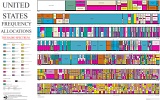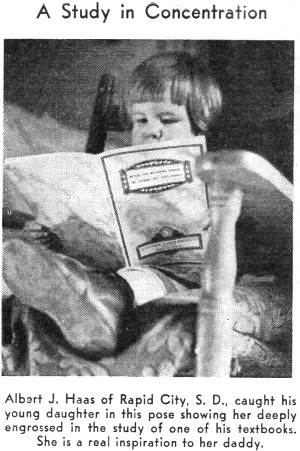|
June/July 1940 National Radio News
 [Table
of Contents] These articles are scanned and OCRed from old editions of the
National Radio News magazine. Here is a list of the
National Radio News articles I have already posted. All copyrights are hereby acknowledged. [Table
of Contents] These articles are scanned and OCRed from old editions of the
National Radio News magazine. Here is a list of the
National Radio News articles I have already posted. All copyrights are hereby acknowledged. |
 National Radio News magazine
was published bi-monthly by the folks at the
National
Radio Institute (NRI). NRI used to be a major training center for electronics
technicians beginning in the early part of the 20th century. This article was provided
for them by the Federal Communications Commission (FCC) as a synopsis of radio frequency
spectrum allocations at the time. Compare a 1940 spectrum allocation chart (just
a simple description here) to one for 2016 and you will see a remarkable difference in not just the number of bands,
but in the extension of the frequency range. This link produces the
FCC Online Table of Frequency Allocations
(July 1, 2022) document, and this one is a more user-friendly
equivalent graphical
U.S. Frequency Allocations chart published by the U.S. Department of
Commerce's National Telecommunications and Information Administration (NTIA)
Office of Spectrum Management, using 2016 data, which appears to be the most
recent. National Radio News magazine
was published bi-monthly by the folks at the
National
Radio Institute (NRI). NRI used to be a major training center for electronics
technicians beginning in the early part of the 20th century. This article was provided
for them by the Federal Communications Commission (FCC) as a synopsis of radio frequency
spectrum allocations at the time. Compare a 1940 spectrum allocation chart (just
a simple description here) to one for 2016 and you will see a remarkable difference in not just the number of bands,
but in the extension of the frequency range. This link produces the
FCC Online Table of Frequency Allocations
(July 1, 2022) document, and this one is a more user-friendly
equivalent graphical
U.S. Frequency Allocations chart published by the U.S. Department of
Commerce's National Telecommunications and Information Administration (NTIA)
Office of Spectrum Management, using 2016 data, which appears to be the most
recent.
BTW, the picture below has nothing to do with the article. It appeared on the
table of contents page and I thought it would make a good addition since the article
itself had no image.
See also
National
Radio Institute advertisement, December 1954 Radio News;
Mathematics
in Radio in July 1932 Radio News;
Measuring Inductance and Capacity, June 1931 Radio-Craft;
Mathematics in Radio,
March 1933 Radio News;
Radio Frequencies and Their Allocation, June | July 1940 National Radio
News;
Your Radio Training and the Defense Program, December 1940 | January 1941
National Radio News. Radio Frequencies and Their Allocation
 This article was released to National Radio
News by the Federal Communications Commission, Washington, D. C. This article was released to National Radio
News by the Federal Communications Commission, Washington, D. C.
The radio spectrum, or radio waves form one portion of the total electromagnetic
spectrum. The electromagnetic spectrum covers eight different classes of radiation-electric
waves, radio waves, infra-red, visible light, ultra-violet, X-rays, gamma rays,
and secondary cosmic rays.
The emission of this energy may be likened to the expanding ripples of water
suddenly disturbed by a thrown stone. However, electromagnetic energy travels in
all directions.
Since electromagnetic radiations have a common speed (that of light), their only
difference is in frequency and wave length. "Frequency" may be characterized as
the number of these waves per second, and "wave length" as the distance between
successive waves.
The divisions between the various classes of electromagnetic radiations are not
definite. The lines of separation are based largely upon the effects and the particular
method of producing the various emissions. Under certain conditions, some of these
electromagnetic impulses may be seen, felt, or heard. Of the eight classes of electromagnetic
radiations, that portion classed as "radio waves" covers a relatively small part
of the total electromagnetic spectrum.
Radio facilities are extremely limited. In order to provide the maximum possible
service for the benefit of the public, it is necessary to control and restrict the
use of the available channels. As transmission by radio waves spans great distances,
it has been found necessary to have international agreement on the proportion of
available channels to be allocated for particular services. To prevent interference
within our own country, it is necessary to further apportion the frequencies in
the best interests of users.
Besides the standard broadcast channels. our radio spectrum is shared by other
primary services, such as: fixed, marine, aviation, emergency, amateur, miscellaneous,
experimental, Government, and broadcast services other than standard broadcast.
These general service allocations cover various classes of station, including: relay,
international broadcast, high frequency broadcast, noncommercial education, facsimile,
television, point-to-point telephone and telegraph, agriculture, press, coastal,
telegraph and telephone, ship, aircraft, aeronautical, blind landing systems, airport,
municipal and State police, marine fire, forestry, geological, mobile press, motion
picture, amateur phone, telegraph and television, as well as experimental classes
of stations.
The present useful radio spectrum, in which channels are now allocated, ranges
from 10 to 300,000 kilocycles, or in terms of wave lengths from 30,000 meters to
1 meter. That portion below 100 kilocycles is popularly referred to as "long waves";
from 100 kilocycles to 550 kilocycles as "medium long waves'"; from 550 to 1600
kilocycles as "broadcast" ; 1600 to 6000 kilocycles as "medium short waves"; 6,000
to 30,000 kilocycles as "short waves"; and above 30,000 kilocycles as "very short"
or "ultra-short waves."
The band below 100 kilocycles is occupied by Government and commercial long wave
fixed service stations. From 100 kilocycles to the beginning of the broadcast band
at 550 kilocycles we have the medium long wave stations, as follows: 100 to 200
kilocycles - Government and private ship, coastal, and fixed service stations.
200 to 400 kilocycles - primarily Government aids to navigation, such as radio
navigation for aircraft, and radio beacon service to ships, interspersed with airport
on 278 kilocycles, direction finding on 375 kilocycles, and miscellaneous fixed
stations.
400 to 550 kilocycles - Government and commercial ship and coast stations in
the maritime service centered near the international calling and distress frequency
of 500 kilocycles (600 meters).
The rest of the spectrum from the end of the "broadcast" band at 1600 kilocycles,
involving the so-called "medium short," "short," and "ultra-short" wave bands, could
be pictured as a many layered sandwich, with police, amateur, aviation. Government,
ship, coastal, broadcast, mobile press, special services, experimental television
fixed, forestry, and all other classes of stations providing varying depths of filling.
Of course, this does not mean that all these bands are completely filled. Radio
communications is still undergoing change, and the Federal Communications Commission,
in licensing individuals and firms to use the public's radioways, is charged with
preparing for the future, as well as for the present. Hence, some channels are held
open for future developments, while others already allocated, are subject to shift
with changing events.
Posted April 10, 2023
(updated from original post
on 4/8/2014)
|










 This article was released to National Radio
News by the Federal Communications Commission, Washington, D. C.
This article was released to National Radio
News by the Federal Communications Commission, Washington, D. C. 